We’ve all been there, the perfect design is calling out to us just itching to be stitched, but how to choose the best fabric for embroidery? Will any fabric on from our stash work or does it need to be the exact one listed in the instructions? Well, the simple answer is that you can embroider onto almost any fabric or material, but each type does have its own benefits and challenges. Stick with us as we guide you through some of the most common types of fabric for embroidery and delve into some more unusual ones - for you adventurous types out there!
If you're brand new to embroidery you can also head over our embroidery for beginners guide or the embroidery stitches library.
Main image: Baby Bonnet by Jevgenija Medvedeva
Cotton fabric
Cotton fabric is commonly available in three different weight classifications; cotton lawn, which is lightweight; cotton poplin, which is light-medium weight; and quilting cotton, which is medium weight.
Quilting weight cotton is ideal for working modern embroidery as it is strong enough to hold the weight of the stitching without warping or snagging, but not too thick that it’s tough to stitch through. It is also dense enough to disguise any trailing threads on the back of the stitching that may be visible through thinner fabrics.

If you’ve got some light-weight fabric in your stash then you can definitely still use it, but we recommend either layering it into your hoop on top of another piece of cotton fabric and then stitching through both layers. Or, back it with light or medium-weight iron-on interfacing to make it more sturdy - this method is ideal for projects that are going to be removed from the hoop and made into something else, such as a hanging or a bag.
Cotton blends or other types of materials such as polyester are not recommended as they can be stretchy and unpredictable, however, they can be made more manageable by treating them in much the same way as the lighter weight cotton by reinforcing with interfacing before inserting them into a hoop ready for stitching. Try the heart embroidery pattern on cotton fabric.
Counted fabric for embroidery (Evenweave, hardanger and Aida)
Counted fabrics have holes in the weave of the fibres that are spaced evenly across the fabric that helps you position your stitching precisely. This type of fabric is essential when working counted forms of embroidery such as cross-stitch, blackwork or hardanger as it needed to work in conjunction with the patterns/charts which are formed on a grid.
What is evenweave fabric?
Evenweave fabric is made up of single threads that are evenly spaced at right angles. It has a more open weave than conventional cotton fabric so you are able to do some specific embroidery techniques with it such as counted thread, drawn thread and pulled thread.
Evenweave fabric can be composed of a wide range of fibres such as cotton, linen, rayon and polyester blends and come in a selection of colours.
Depending on the project you will want to select the appropriate fabric count as that will affect how the finished project will turn out. They range from 32-count down to 18-count. For fine, very detailed designs aim for a higher count number and for larger, less complex designs choose a lower count.
What is Aida fabric?
Aida fabric (or Aida cloth) is made up of groups of threads that are evenly spaced at right angles and is predominantly used for cross stitch due to its clear square grid structure and visible holes which, makes it easy to count. It can however be used for other types of embroidery such as blackwork, counted thread, and Assisi embroidery.
Although Aida is the most common there are other types of cross stitch fabric and materials that can be used such as soluble canvas for working cross stitch onto non-counted fabric and plastic canvas.
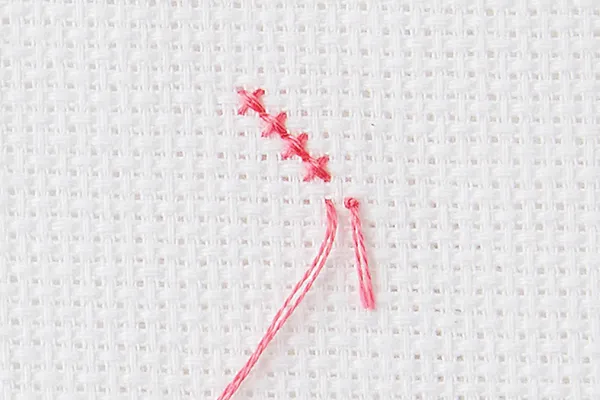
Like with evenweave, Aida fabric can be composed of a wide range of fibres such as cotton, linen, rayon and polyester blends and come in a selection of colours.
To adjust the size and complexity of the design select the appropriate fabric count as that will affect how the finished project will turn out. Aida ranges from 11-count to 22-count. The number equates to the number of holes per inch so, 11-count will be a larger grid and the 22-count will be a smaller grid.
What is hardanger fabric?
Modern Hardanger fabric is a 22-count evenweave fabric that is similar in appearance to Aida but with double threads that are evenly spaced at right angles. The fabric is made of 100% cotton and it is most commonly used specifically for hardanger embroidery technique (also known as whitework embroidery). It can also be used in the same way as evenweave with each double thread group counted as one or for cross stitch where it is worked over two double thread groups, making it the equivalent of 11-count Aida.
Embroidery onto linen
Linen is a type of fabric made from the fibres of the flax plant which not only gives it a distinctive natural look but also make it soft and durable.
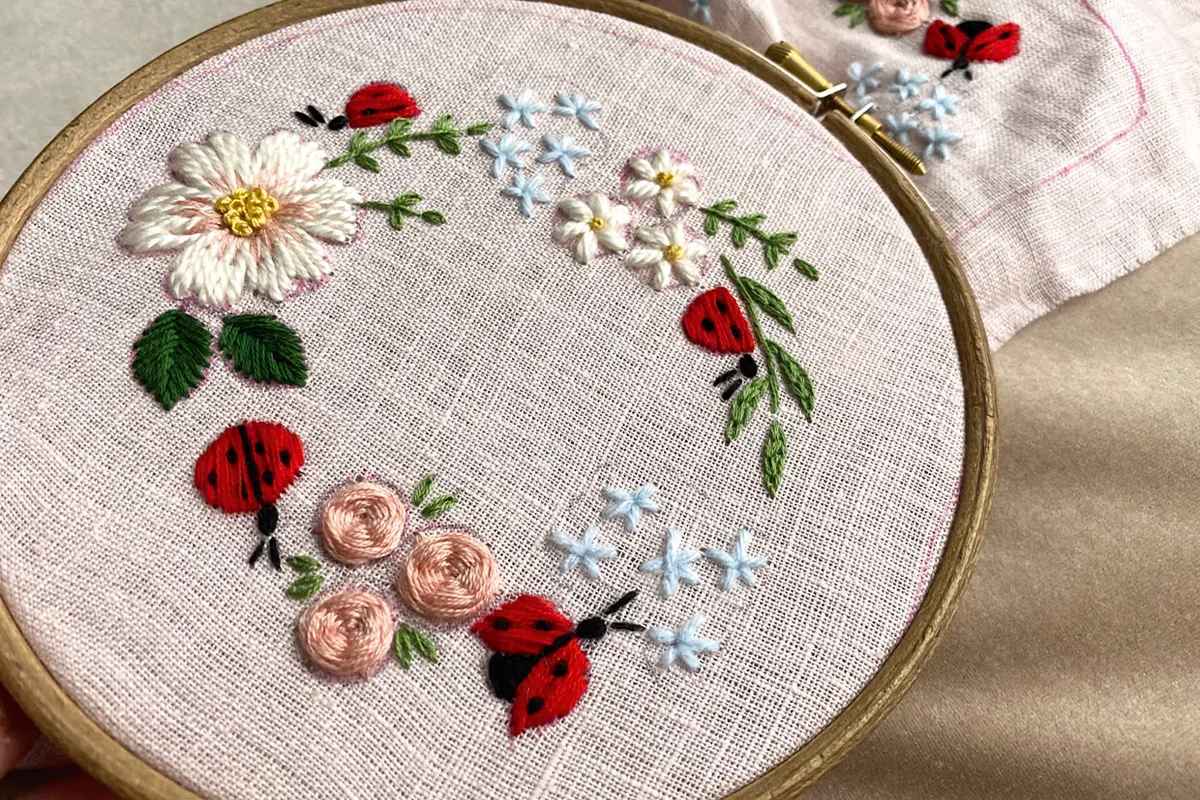
It is a versatile fabric as it can be worked on in much the same way as quilting cotton without the need of reinforcement, but is also an evenweave fabric so is suitable for projects that require a counted thread technique. Take on the linen baby bonnet embroidery.
Embroidery on felt fabric
Felt is a great material to embroider onto because it doesn’t fray and can therefore easily be transformed into items such as brooches, or decorations. or embroidered earrings (photo below). Felt fabric for embroidery comes in a selection of varieties:
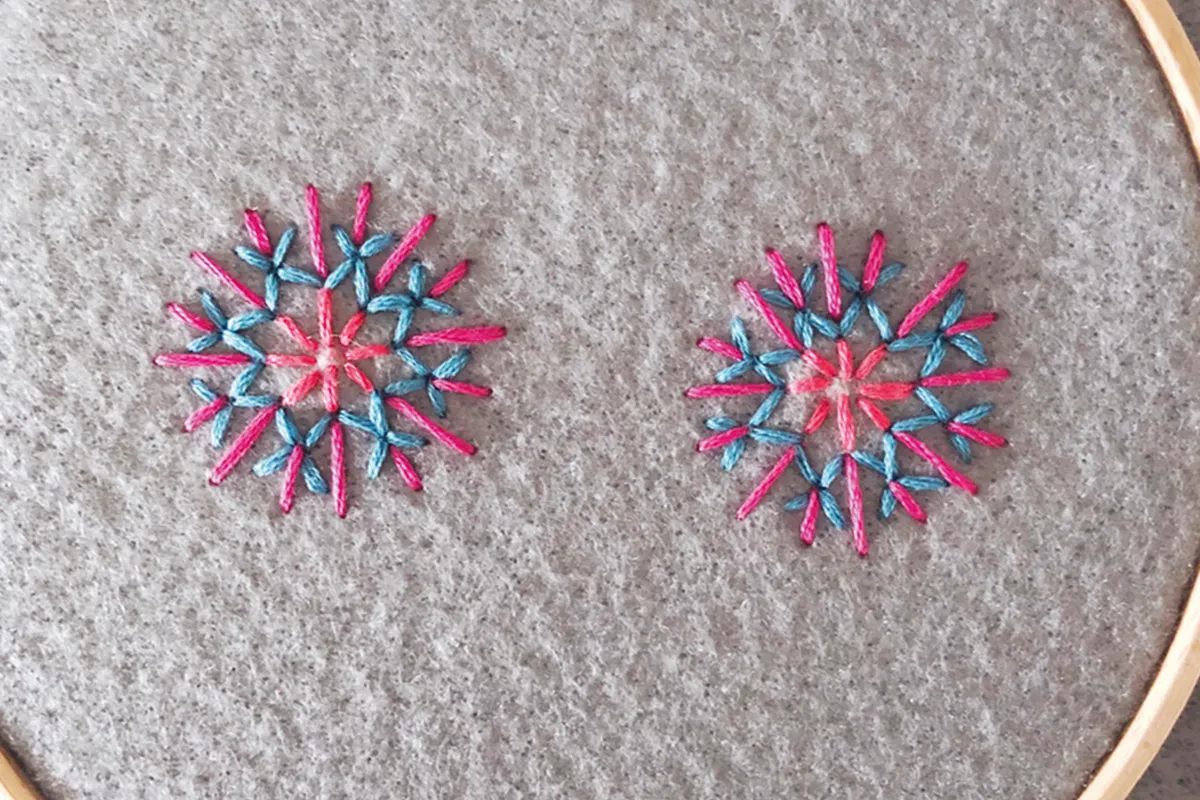
- 100% wool felt - which as its name suggests is made of 100% natural wool and comes in thicknesses of 1.2 mm, 2mm, 3mm, and 5mm.
- Blended wool felt - which is composed of a blend of wool and rayon.
- Craft felt – which is 100% synthetic fabric for embroidery and is available in a wide selection of bright colours and glitter options.
- Bamboo/rayon blend - which is made from bamboo fibres and rayon.
- Eco-fi felt - which is an eco-friendly felt made of Eco-fi which is a polyester fibre made from 100% recycled plastic bottles.
When choosing which felt option will work for you, note that the thinner felt fabric for embroidery is suitable for most embroidery projects whereas the thicker options are more suited to home wear items and projects that require durability.
100% Wool felt or blended wool felt is most commonly used for embroidery as it’s naturally softer and easier to stitch through, but you can use other types of felt just try to make sure it’s nice and soft.
Embroidery onto Ready-Made Items or clothing
You can embroider onto almost any fabric item provided you have the right equipment. Items such as pillowcases, aprons or napkins can be easily stitched onto as you would with standard cotton fabric. But there are a few things to consider before you begin stitching.
If you are stitching onto an item where the back of your stitching will be visible, such as a scarf or tea towel, use the loop start method as this will keep the back looking neat and knot-free if possible. To do this, cut a double length of thread and then fold the strand in half to create a two-strand thickness. Then, thread the cut ends through your needle, work a stitch and then slip your needle through the loop at the back to secure it in place - this method can be used for any even number of strands.
Clothing made of thin or stretchy fabric, such as a t-shirt may require the use of stabiliser or interfacing to help keep its structure while you stitch or the finished embroidery may be warped or cause the material to pucker.
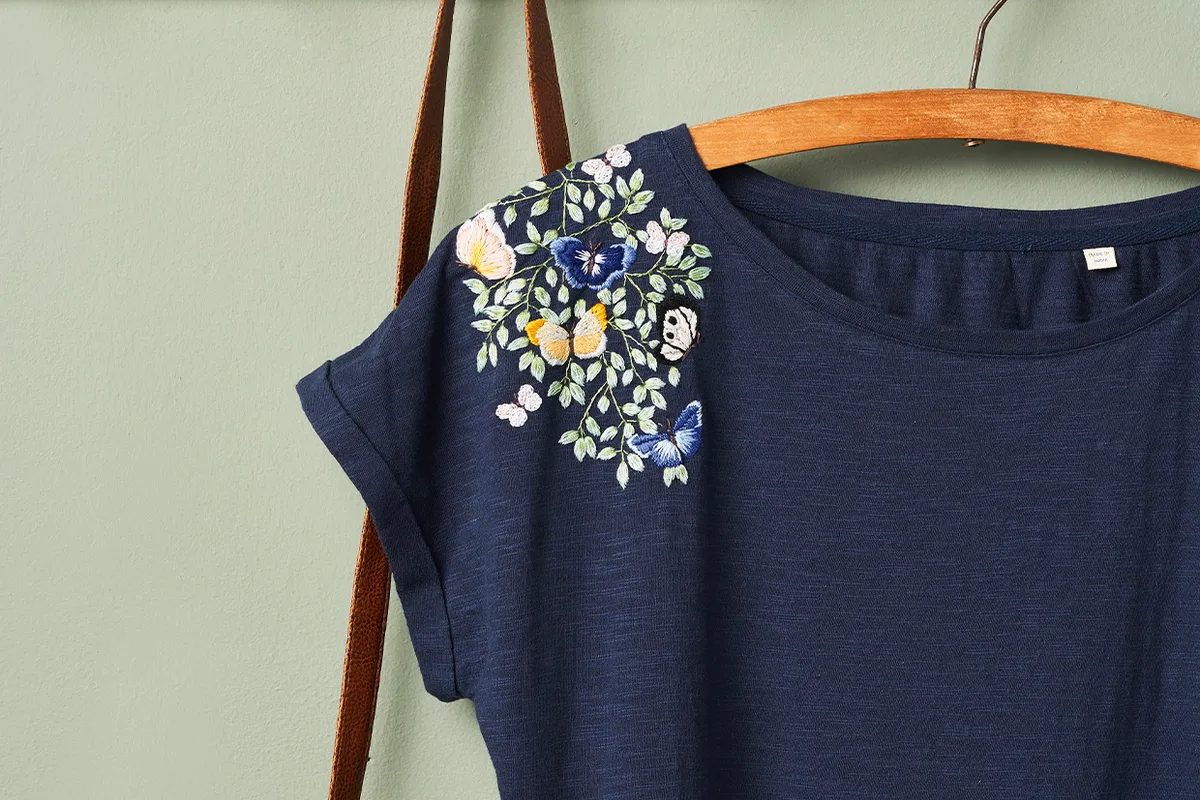
A hoop is also recommended when stitching onto clothing as it’s important to keep the tension of your stitching even. If your garment is made of very soft fabric, such as cashmere, then you may find it is slipping in your hoop, to prevent this try wrapping the inner hoop with bias binding to help create grip.
Stiff materials such as leather or canvas shoes can also be embroidered onto but will require a specific type of needle to combat the tough material. For leather use a Leather/Glover needle and for other coarse fabrics use a Chenille needle.
When embroidering onto knitted or crochet items such as mittens or jumpers it’s worth bearing in mind that knitted fabric has an open weave and is very stretchy. In order to combat this, we recommend the use of a stabiliser to transfer your design which will prevent it from warping or bunching as you stitch. Alternatively, you can freehand stitch onto knitted or crochet fabric without following a pattern, but you will need to ensure to keep your tension even as you work.
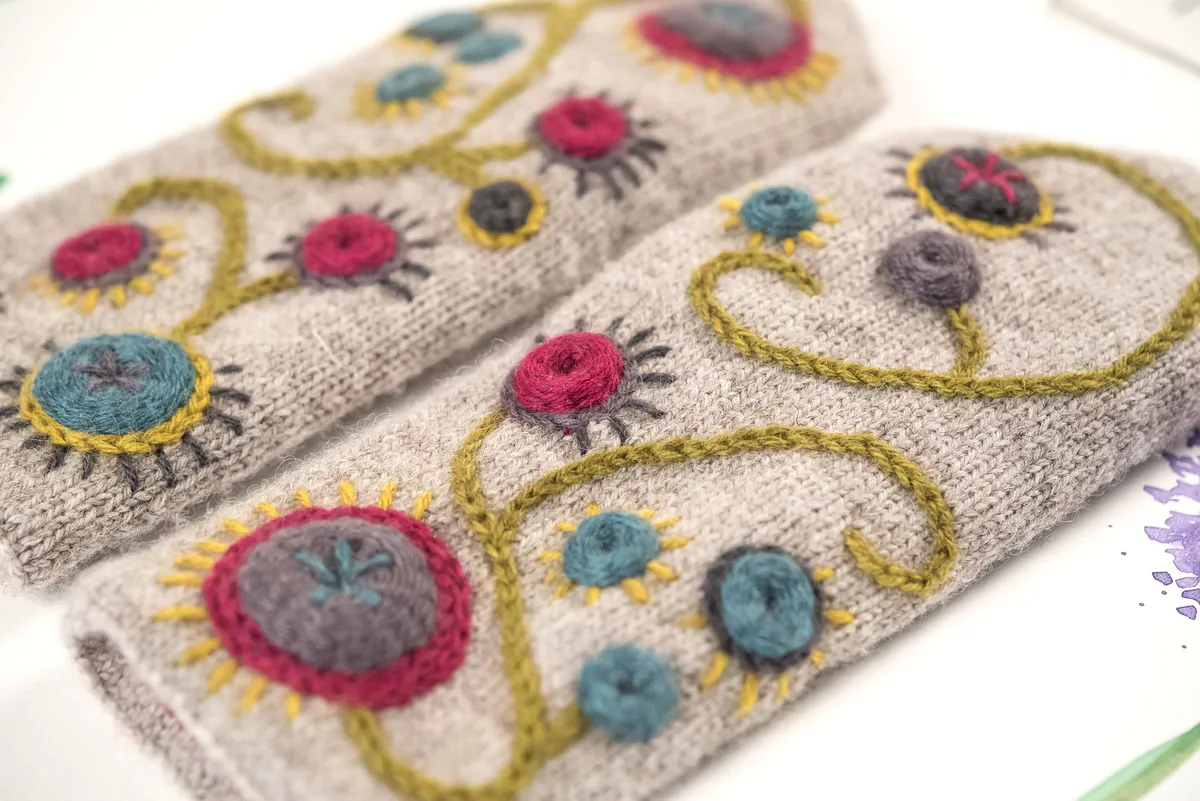
Embroidery on tulle or organza
Tulle and organza are some of the potentially more difficult types of fabric to stitch onto, but it’s totally achievable with a few tricks up your sleeve. With both types of fabric for embroidery, it’s important to bear in mind that any trailing thread will be visible through the fabric so make sure you stop and start when moving onto a fresh area on the design or weave through the back of previous stitches to get to the next area.
What is Tulle?
Tulle is a lightweight stiff netting that is most commonly made of polyester but can also be made of silk or nylon. Its open structure means that it’s very easy to distort the weave of the fabric so be careful not to pull it out of shape when you mount it into your hoop ready for stitching
What is Organza?
Organza is a sheer, lightweight fabric that has an extremely low-density weave. When selecting organza for embroidery, search for fabric that feels slightly silky and smooth but still relatively sturdy.
More embroidery on Gathered to try
Now you know some tips and tricks on what fabric to use for embroidery why not try customising your clothing with some embroidered lettering, making an inspirational banner to add some positive vibes to your home or accessorise an outfit with some fan tassel earrings. There are so many free embroidery projects on gathered ready for you to explore so take a look around.
